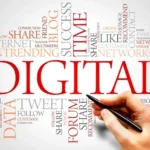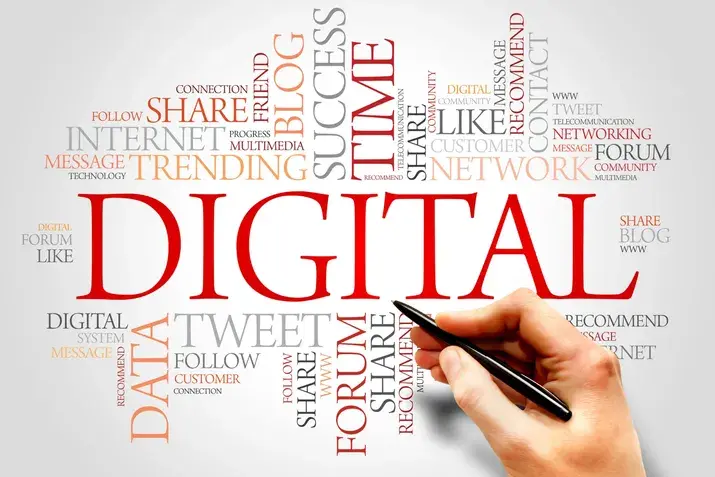Table of Contents

In the digital age, marketing has beaten traditional boundaries and has become a dynamic and multidisciplinary field of study called digital marketing. You may be a beginner who wants to learn the basics or a professional who wants to upgrade their skills. But what exactly digital marketing is? This complete guide will introduce you to the basics and advanced digital marketing methods. Lets jump to the What is digital marketing and its types.
Definition and Scope
Digital marketing refers to all marketing activities that use electronic devices or the Internet. Companies use digital media such as search engines, social media, email, and websites to reach existing and potential customers. Whether you are a startup or a well-established business, beginners must understand the basics of digital marketing to grow in the competitive market.
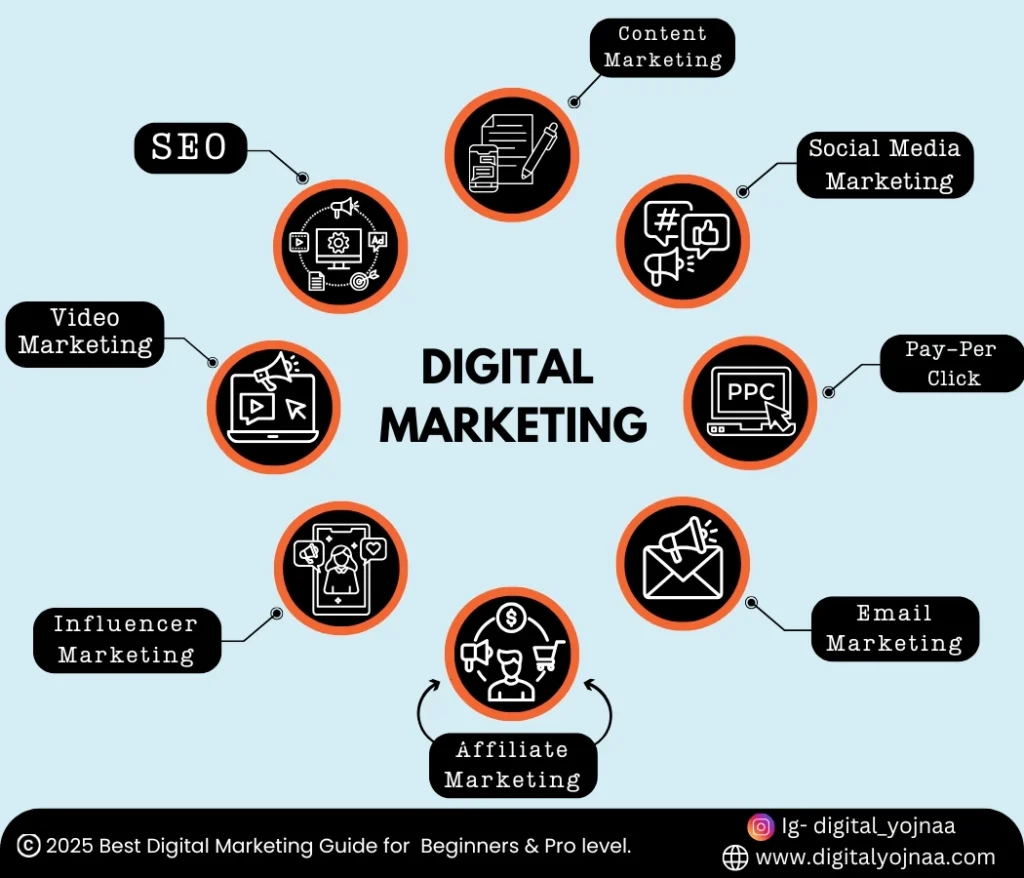
What is Digital Marketing and Its Types
For those who are just starting, it’s important to understand that What is digital marketing and its types. Digital marketing combines creativity with analytical skills to attract, engage, and convert potential customers.What is digital marketing and its types
Step-by-Step 6 Digital Marketing Strategy Guide
Here’s a simple roadmap to start digital marketing:
- Identify Your Audience
- Create Valuable Content
- Optimize Your Website with SEO
- Leverage Social Media Platforms
- Invest in PPC Campaigns
- Monitor and Improve Using Analytics
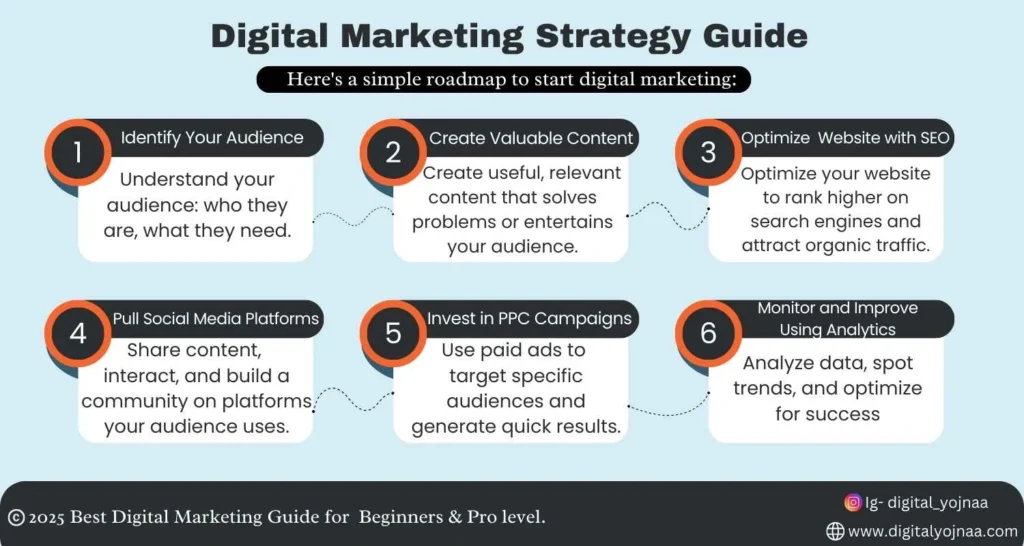
Key Components of Digital Marketing
Digital marketing is not a single structure but a mix of several components, each with its unique role. These are SEO and content marketing basics, social media marketing, PPC, email marketing, affiliate marketing, influencer marketing, and video marketing.
Difference between Traditional and Digital Marketing.
While traditional marketing is based on offline media such as TV, radio, and print media, digital marketing is based on online media. The most important differences are reach, cost, engagement, and scalability. Digital marketing offers more targeted reach, real-time information, and higher levels of engagement than traditional marketing.

History of Digital Marketing
Digital marketing has evolved considerably since the early days of the internet. In the 1990s, websites emerged as digital brochures, and email marketing became a new channel to reach consumers. Over time, the advent of search engines, social media platforms, and mobile technologies has transformed digital marketing into a sophisticated discipline. Key milestones include the rise of Google as a search giant, the proliferation of social networks such as Facebook and Twitter, and the integration of data analytics into marketing strategies. What digital marketing is and its types
Importance of Digital Marketing in Today’s World
Digital marketing and its impact on revenue generation is crucial. In today’s fast-paced digital landscape, digital marketing is a must. It offers businesses of all sizes the ability to reach a global audience with accuracy and cost efficiency with the right digital marketing strategy.
The importance of digital marketing lies in its ability to deliver measurable results, engage audiences through interactive content, and foster brand loyalty. With consumers increasingly relying on digital tools for information and purchase decisions, a well-crafted digital marketing strategy ensures that brands remain competitive and visible.
8 Different Types of Digital Marketing
Digital marketing challenges one-dimensional thinking; instead, it is a blend of interdependent elements, each of which is a vital component of a comprehensive strategy.
1. Search Engine Optimization (SEO)

Search engine optimization is the cornerstone of digital marketing, focused on increasing a website’s visibility on search engine results pages (SERPs). By optimizing content and technical aspects, businesses can improve their rankings, attract organic traffic, and reach a wider audience. Key SEO strategies include keyword research, on-page optimization, link building, and technical adjustments such as improving site speed and mobile-friendliness. Effective SEO requires an ongoing process of analysis, optimization, and content refinement.
On-page vs. off-page SEO
On-page: Includes content optimization, meta descriptions, image alt-text, and strategic internal linkage.
Off-page: Focuses on obtaining authoritative backlinks and increasing digital reputation. Together, these aspects combine into a strong SEO strategy.
2. Content Marketing
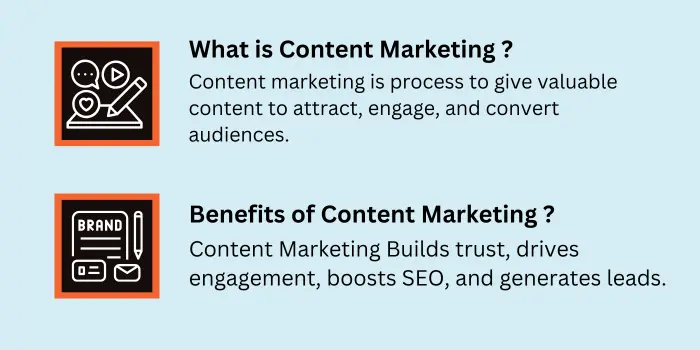
Content marketing is a strategic approach that focuses on creating and distributing valuable, relevant, and consistent content to attract and retain a clearly defined audience. Its goal is to drive profitable customer action by providing insightful information that meets the needs and interests of the target market. Strategies include blog posts, e-books, infographics, podcasts, and videos. Quality content builds trust, boosts engagement, and establishes a brand as an authority in its field. For beginners, understanding the importance of content planning, audience research, and distribution
Content Marketing Strategies Examples
Content marketing strategy examples are all about delivering valuable content that educates, informs, or entertains your audience. Effective content marketing strategies for beginners include blog posts, videos, infographics, and podcast
3. Social Media Marketing

Social media marketing harnesses the power of platforms like Facebook, Instagram, Twitter, and LinkedIn to promote brands and connect with audiences. It involves creating engaging content, building communities, and leveraging social networks to boost brand awareness and conversions. Social media offers unique opportunities for real-time engagement, customer feedback, and viral marketing. Beginners should focus on understanding the unique features of each platform, setting clear goals, and measuring performance through analytics. Building brand awareness through social media marketing for beginners is a powerful way to grow your business. What is digital marketing and its types
4. Pay-Per-Click (PPC) Advertising
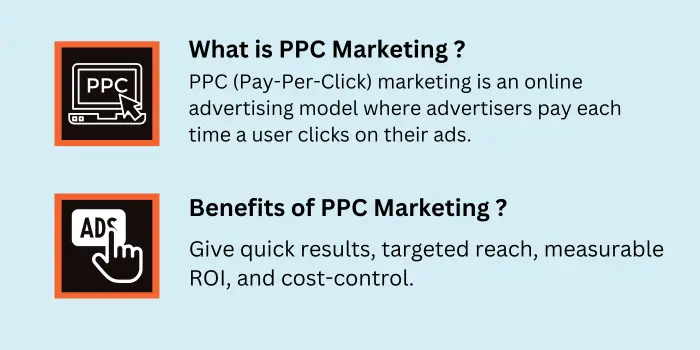
Pay-per-click (PPC) advertising guide is a model in which advertisers pay a fee every time one of their ads is clicked. It provides instant visibility and the ability to target specific audiences based on demographics, interests, and behaviors. Platforms such as Google Ads and social media networks offer robust tools for setting up and managing PPC campaigns.

For beginners, understanding PPC involves learning about bidding strategies, keyword research, ad copy creation, and budget management. When executed effectively, PPC campaigns can generate immediate traffic and complement organic marketing efforts by increasing overall brand exposure and conversions through targeted ads. What is digital marketing and its types
5. Email Marketing

Email marketing is one of the most effective tools for direct communication with customers. It allows businesses to deliver personalized messages, nurture leads, and build lasting relationships. Successful email campaigns rely on well-segmented lists, compelling subject lines, and relevant content that directly addresses the recipient’s needs. Automation and analytics play a key role in optimizing these campaigns by tracking engagement, open rates, and conversion metrics. For beginners, mastering the art of email marketing involves understanding how to design responsive emails, craft persuasive copy, and integrate calls-to-action that deliver measurable results. What is digital marketing and its types
This direct line to consumers is invaluable for continued engagement. Crafting personalized email campaigns ensures customer retention and boosts sales. Implementing best practices in email marketing can yield impressive results.
6. Affiliate Marketing
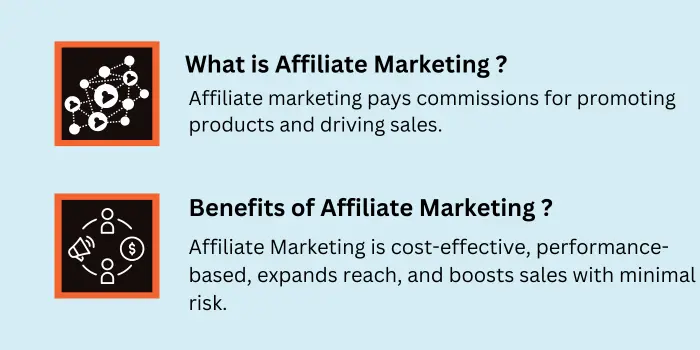
Affiliate marketing is a performance-based strategy where businesses reward affiliates for driving traffic or sales through their referrals. This approach leverages the influence and reach of partners who promote products or services to their audience. For beginners, affiliate marketing represents a low-risk method to expand market reach, as payments are only made when a desired action occurs. Setting up an affiliate program involves choosing the right partners, defining clear commission structures, and tracking performance through reliable analytics.
7. Influencer Marketing

Influencer marketing involves partnering with individuals who have a significant following online to promote products or services. These influencers, who often enjoy a high level of trust among their audiences, can authentically showcase a brand’s offering in a way that resonates with potential customers. For the uninitiated, this form of marketing requires carefully selecting influencers whose values align with the brand’s and whose audience demographics match the target market. Successful campaigns are based on genuine relationships and transparent collaboration, ensuring that promotions appear authentic.
8. Video Marketing

Video marketing has emerged as a major force in digital marketing, engaging audiences with engaging and dynamic content. Videos can simplify complex topics, showcase products in action, and tell compelling brand stories. Platforms like YouTube, Facebook, and Instagram offer vast opportunities for video distribution and audience engagement. For beginners, investing in video content means understanding the basics of scripting, shooting, and editing. High-quality videos can boost SEO, increase time spent on your website, and significantly impact conversion rates.
Advantages of Digital Marketing
- Cost-Effectiveness – Digital marketing offers affordable solutions for businesses of all sizes.
- Measurable Results – Using tools like Google Analytics helps track campaign performance.
- Enhanced Customer Engagement – Digital platforms allow businesses to interact directly with their customers.
Choosing the Right Digital Channels
1. Online vs. Offline
While online channels offer immediate feedback and data-driven insights, offline channels such as events and direct mail still have their place in a comprehensive strategy. A balanced approach often yields the best results.
2. Finding the Best Platforms
Not every platform will be right for your business. It’s important to know where your target audience spends their time and optimize your efforts for those platforms. For example, B2B companies may find LinkedIn more effective, while B2C brands may perform better on Instagram or Facebook.
Building a Digital Marketing Strategy
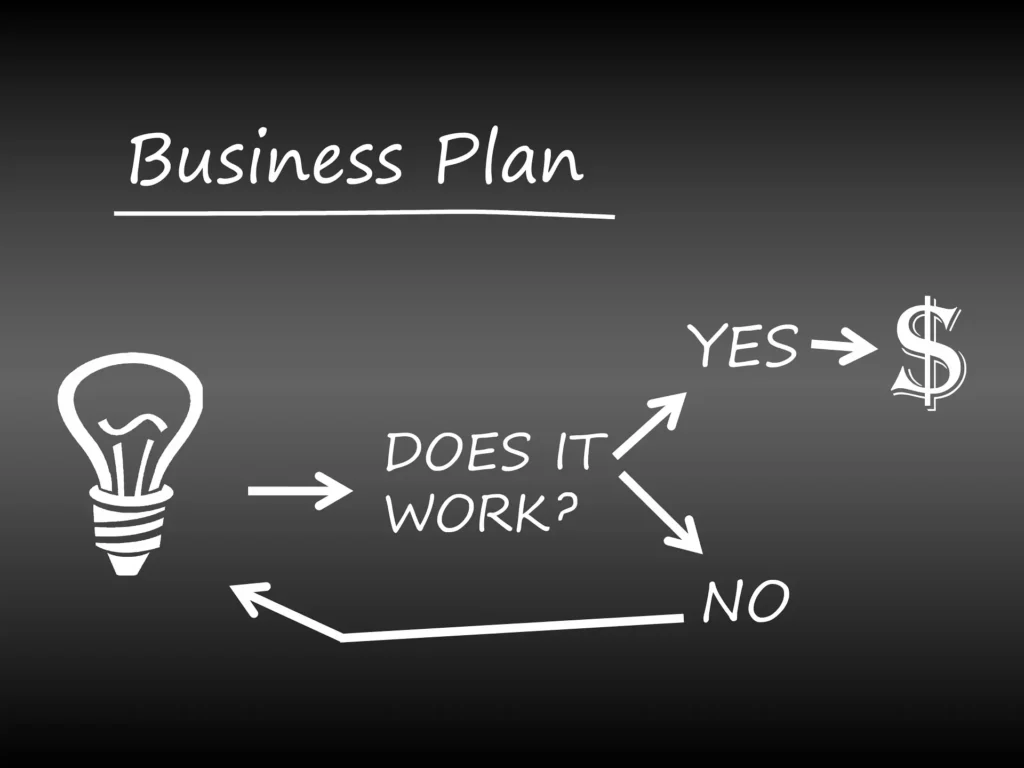
Set Clear Goals
Before you begin, determine your goals. Do you want to increase brand awareness, drive website traffic, generate leads, or increase sales? Clear, measurable objectives will help guide your strategy and determine success.
- Know your audience
Understanding your target audience is crucial. Create buyer personas that detail the demographics, interests, and pain points of your ideal customers. This allows you to craft your marketing messages.
- Choose your channels
Based on your target audience, choose the digital marketing channels that will yield the best results. A multi-channel approach often helps you reach more potential customers.
- Budget and resources
Every marketing plan requires a budget. Allocate your resources to the areas that offer the most impact. Consider costs for equipment, advertising, content creation, and manpower. Prioritize based on your objectives and audience.
- Measure your success
Use simple tools to track your results. Look at numbers like website visitors, clicks, and sales to see what works and what needs to change.
5 best Tools for Digital Marketing
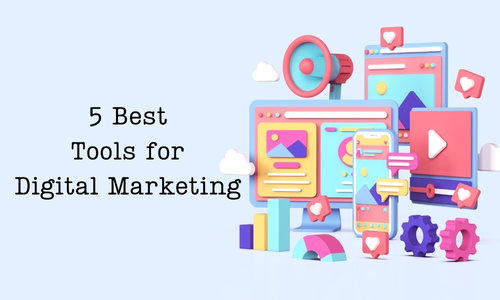
- Analytics Tools
Google Analytics is a powerhouse for tracking website performance, user behavior, and conversion rates. Tools like Adobe Analytics and Mixpanel provide additional insights, allowing you to make data-driven decisions.
- SEO Tools
Tools like SEMrush, Ahrefs, and Moz are essential for keyword research, site audits, and backlink analysis. They help ensure that your website is optimized for search engines, which increases organic traffic.
- Social Media Tools
Platforms like Hootsuite, Buffer, and Sprout Social allow you to schedule posts, monitor engagement, and analyze social media performance across different channels. These tools save time and streamline your social media efforts.
- Email Tools
Email platforms like MailChimp, Constant Contact, and HubSpot offer user-friendly interfaces, automation capabilities, and analytics. They help you design, send, and track email campaigns efficiently.
- Automation Tools
Automation is a huge change in digital marketing. Tools like MarketoWhat , Pardot, and Active Campaign automate repetitive tasks like email campaigns, social media posting, and lead nurturing. This not only saves time but also ensures consistent engagement with your audience.
Advice for Beginners

- Start Small what is digital marketing and its types
Start with small projects and learn as you go. This helps you avoid mistakes and build confidence.
- Learn from Others
Read blogs, watch webinars, and join communities to learn from people who know digital marketing well.
- Keep Improving
Always test new ideas and adjust your plan. Learning from experience is the key to long-term success.
Common Mistakes to Avoid

- No Clear Plan
Jumping into digital marketing without a clear strategy is a recipe for failure. Without defined objectives and a solid plan, your efforts can be scattered and ineffective.
- Ignoring Data
Failing to monitor and analyze your campaigns means missing out on important information. Regular analysis helps you understand what’s working and adjust strategies accordingly, ensuring you don’t waste resources.
- Not Optimizing for Mobile
Since most internet users access content via a mobile device, having a mobile-optimized website is very important. If your site isn’t mobile-friendly, you risk losing a significant portion of your audience.
- Poor Quality Content
Quality content is the core of every successful digital marketing campaign. Poorly crafted content can harm your brand’s reputation and fail to attract your target audience.
- Not Adapting to Change
The digital landscape is constantly evolving. Not keeping up with the latest trends and innovations can make your strategy outdated. Constant learning and adaptation is key to staying relevant.
Tips for Experts
- Use Data and AI
Advanced marketers are increasingly using data and artificial intelligence to gain insights. Predictive analytics and machine learning help you understand customer behavior and refine targeting strategies, ensuring your campaigns are both effective and efficient.
- Personalize Your Message
Personalization is no longer optional. Tailor your marketing messages to individual customer preferences. Customer journey mapping helps you see every interaction a customer has with your brand, allowing you to optimize each touchpoint for a better user experience.
- Advanced SEO Tips
Once you learn the basics, take your SEO efforts to the next level. Techniques like schema markup, voice search optimization, and international SEO can give you a competitive edge in a crowded online marketplace.
- Combine Online and Offline
The omnichannel approach ensures a seamless customer experience across all platforms – online and offline. Integrate your marketing efforts so every channel works together to deliver a consistent and engaging brand experience.
- Keep Up with Trends
The digital marketing industry is incredibly fast-paced. Make it a habit to stay updated with the latest trends, tools, and best practices. Follow industry blogs, attend webinars, and participate in digital marketing communities to keep your skills sharp.
Real-Life Examples
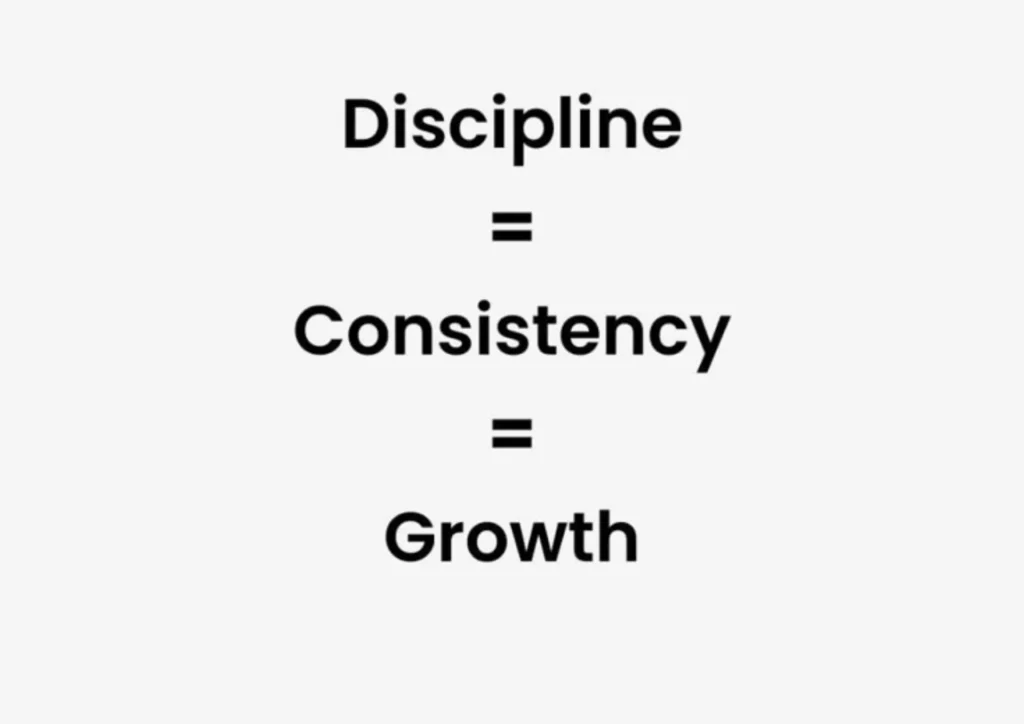
- Successful Campaigns
Look for examples of brands that do digital marketing well. They often use good content and a personal touch to win over customers.
- Learning from Mistakes
Not every campaign is successful. Learning from past mistakes helps you avoid problems later.
10 Essential Digital Marketing Statistics

- 5 billion people use the internet globally (2023), making digital marketing essential to reach a huge audience.
- 60% of marketers say SEO generates the most leads, which shows its importance in increasing organic traffic.
- Video content drives 80% of consumer internet traffic, making it a powerful tool for engagement.
- 74% of consumers rely on social media for purchases, which emphasizes the role of social platforms in decision-making.
- The average 36forevery1 spend on email marketing ROI proves its effectiveness as a cost-efficient strategy.
- 93% of online experiences begin with search engines, underscoring the need for strong SEO practices.
- Mobile devices account for more than 50% of global web traffic, making mobile optimization crucial.
- 80% of shoppers conduct research online before making a purchase, which shows the importance of a strong digital presence.
- Personalized CTAs perform 202% better than generic CTAs, demonstrating the value of optimized content.
- Businesses that use analytics are 3x more likely to see better ROI, highlighting the power of data-driven strategies.
The Future of Digital Marketing
- New Technologies
New tools like virtual reality and blockchain are transforming digital marketing. They offer new ways to connect with people.
- What to Expect
Expect more personalized marketing and a mix of online and offline efforts. Companies that adapt will lead the market.
Combining Offline and Online Marketing
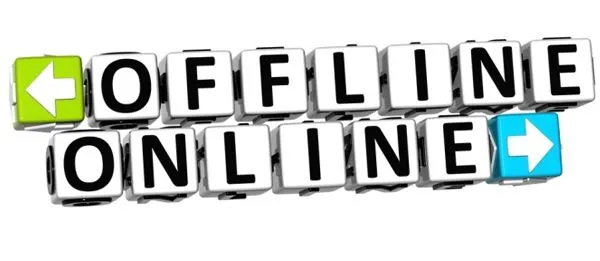
- The Best of Both
A strong holistic approach can be achieved by using both digital and traditional methods. Offline methods like events can boost your online efforts and vice versa.
- How to Mix Them
Plan live events and use online tools like QR codes to connect your offline and online worlds.
Personal Touch in Marketing
- Make It Personal
Tailor your marketing to each customer. This will make your messages more effective and build trust.
- Tools for Personalization
Use customer data to create targeted messaging. Tools like CRM systems can help you keep track of your customer’s needs.
Budgeting for Success
- Spend Wisely
Focus your budget on what works best for your goals. Spend money on high-quality content and useful tools.
- Cost-Effective Strategies
Even with a small budget, you can see great results by focusing on organic growth through SEO and social media.
Frequently Asked Questions (FAQs)
1. What is digital marketing and why is it important?
Digital marketing is the practice of promoting products and services using digital channels. It’s crucial because it enables businesses to reach a broader audience with cost-effective methods.
2. How do beginners start with digital marketing?
Beginners can start by learning the digital marketing basics for beginners, understanding key tools, and experimenting with various platforms.
3. What are the best digital marketing tools for new learners?
Some of the best digital marketing tools for beginners include Google Analytics, SEMrush, and Canva for effective content creation and performance tracking.
4. How can digital marketing increase business revenue?
Digital marketing and its impact on revenue generation enhances visibility, attracts targeted audiences, and boosts conversions, ultimately driving more revenue.
5. What are some proven digital marketing tips for beginners?
Start with clear goals, create quality content, leverage SEO, and utilize digital marketing techniques for beginners for maximum impact.
6. What is Digital Marketing, Its Types, and How It Works?
Digital marketing is the practice of promoting products or services using online channels such as SEO (Search Engine Optimization), PPC (Pay-Per-Click Advertising), content marketing, social media marketing (SMM), email marketing, affiliate marketing, influencer marketing, and mobile marketing. It helps businesses increase brand awareness, generate website traffic, and improve conversion rates.
- SEO improves website ranking on search engines for organic traffic.
- PPC involves paid ads for instant visibility on Google and social platforms.
- Content marketing focuses on creating valuable blogs, videos, and infographics.
- Social media marketing (SMM) uses platforms like Facebook, Instagram, and LinkedIn to engage audiences.
- Email marketing helps nurture leads and retain customers.
- Affiliate marketing allows businesses to earn commissions by promoting third-party products.
- Influencer marketing leverages social media influencers to boost brand credibility.
- Mobile marketing targets users via SMS, apps, and mobile-optimized ads.
To measure success, businesses track key metrics like website traffic, conversion rates, social media engagement, email open rates, and ROI on paid ads. Emerging trends in digital marketing include AI-powered marketing, voice search optimization, video content dominance, and personalized customer experiences.
Conclusion
Digital marketing is a rapidly changing field with many opportunities to grow your business. Whether you are new or experienced, the important thing is to understand what digital marketing is and its types, use the right tools, and always be ready to learn and change. With a clear plan and a focus on good content, social media, and simple data tracking, you can succeed in the digital world.
Please feel free to share your thoughts and leave a review
 seolounge
seolounge
